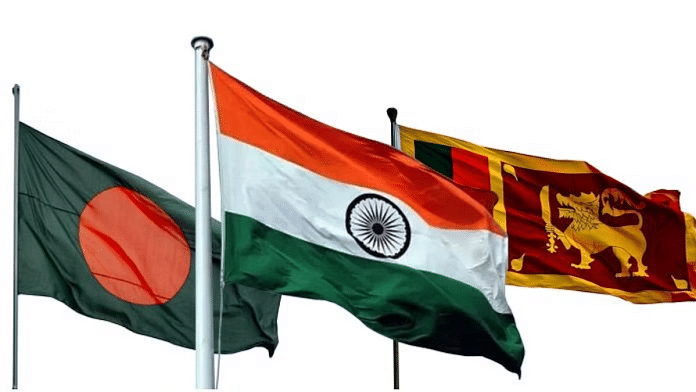Thank you dear subscribers, we are overwhelmed with your response.
Your Turn is a unique section from ThePrint featuring points of view from its subscribers. If you are a subscriber, have a point of view, please send it to us. If not, do subscribe here: https://theprint.in/subscribe/
At a time when Aruna Kumara Dissanayake is making his maiden visit to India as the president of Sri Lanka, let’s look at another important neighbour Bangladesh and make sense of how the ‘Aragalaya movement’ in Sri Lanka in 2022 didn’t have as much adverse impact on India-Sri Lanka ties as did the protests against the quota reforms in Bangladesh, earlier this year, had on India’s ties with the country.
Firstly, there’s a difference in the character of the movements. While the movement in Sri Lanka was mostly for economic reasons, the protest in Bangladesh were much more political in nature. As a result of the same, a government of traditional parties supporting a traditional political figure like Ranil Wickremesinghe as the president overlooked the initial phase of economic stabilization process securing a bailout from the IMF. On the other hand, an interim government led by unelected advisors is expected to reform the most important aspects of the political system in Bangladesh, including the judiciary.
The antipathy not just towards the political elite but also the older political system in Bangladesh is reflected in the reports that suggest while the BNP might be willing to let the Awami league to participate in what all of us expect to be an upcoming free & fair election in Bangladesh, the representatives of the student movement might be advocating for a ban on AL. While on one hand, BNP leader & former PM Khaleda Zia insisted on ‘no anger’ or ‘no revenge’, the interim government began a trial against deposed PM Hasina in ICT of Bangladesh & seems firm on her extradition from India signalling further challenges that the relationship may face.
China, which had a big economic presence in Sri Lanka before the protests in 2022 and was indeed a firm partner of the Sheikh Hasina regime in Bangladesh, isn’t a significant political issue in both the countries as India is. This can be taken as evidence of the larger cultural affinities and animosities India experiences in its neighbourhood compared to China and must prompt us to reflect on our own policies in our own region.
Let’s consider some meetings: PM Modi’s meeting with the then opposition leader Mahinda Rajapaksa during his visit to Srilanka in June2019, when there was already an attempt made by President Sirisena & Rajapaksa together to overthrow the government of PM Wickremesinghe in 2018, which the Supreme court overturned. Then there is the visit of then opposition leader Aruna Kumara Dissanayake to New Delhi in February 2024. On the other hand there was this warm meet up that Sheikh Hasina had with the first family of INC when she visited India for PM Modi’s swearing in, earlier this year as well as the meeting the former PM of Bangladesh had with the Chief mister of West Bengal, Mamata Banerjee in 2019. These random examples suggest that India maintained a cross-partisan approach towards Sri Lanka and that PM Sheikh
China’s role in Sri Lanka and Bangladesh is less politically charged than India’s, reflecting India’s deeper cultural ties and animosities in the region, urging policy reflection.
Hasina also did the same with all political forces in India.
The question here is whether India took all political forces into consideration while building this extremely important relationship with Bangladesh. One can point to the meeting PM Modi had with then opposition leader in Bangladesh Begum Khaleda Zia in 2015. One can also argue that the hyper-partisan nature of Bangladeshi politics compared to that of Sri Lanka makes it difficult for India to pursue nonpartisan relations. However, if we take a look at the violent protests that took place during PM Modi’s bilateral visit to Bangladesh in March 2021, we can conclude that India completely left a big political constituency, beyond the traditional AL and to a certain extent even the BNP, undressed. EAM’s first statement in the parliament on the issue, which raised concerns regarding attacks on minorities in Bangladesh and didn’t include the mention of students killed during the protests against the quota reforms, demonstrates the negligence of India further on.
I write this piece on 16th December, the date on which PM Indira Gandhi declared on AIR, in 1971, that “Dhaka is now a free capital of a free country”. I didn’t come across any report, at least in the top pages, about New Delhi & Bangladesh sharing congratulatory messages. I guess that the MEA is preoccupied with the visit of the president of Sri Lanka, and I hope, I’m proven wrong. Anyway, we in India might have to get acquainted with the reality that August 5, 2024, is a prominent date in Bangladesh’s history than 16th December. History which is much more dynamic rather than static in this subcontinent.
These pieces are being published as they have been received – they have not been edited/fact-checked by ThePrint


